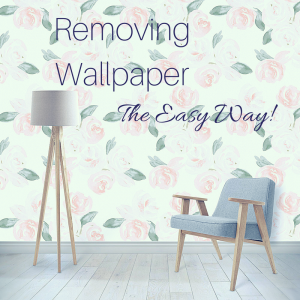
Let’s face it… if you buy a house with out of date wallpaper, chances are, that’ll be the first thing you want off of the walls. Before you apply paint, tile or a different wall-covering, you may have a little work to do. if you are lucky you will only have wallpaper in a couple of places, bedroom or bathroom; if in the kitchen it can be a bit cumbersome working around appliances. Removing old wallpaper is not that difficult, especially if you follow these simple instructions.
Identify your wall type:
- Plaster: it’s found mostly in homes that are more than 50 years old. In plaster walls, wood lath is nailed to the wood-framed walls and covered with two or three coats of plaster. These walls are more solid and sound dull if you knock on them.
- Drywall: It’s been used in homes for the past 50 years or so. Drywall is a sheet of chalk-like substance covered with a lightweight cardboard. These sheets are nailed over wood-framed walls and have a hollow sound when you knock on them. Drywall is more delicate than plaster, so you will need to be sure to not damage the cardboard facing when using a wallpaper scraping tool.
A Little Prep Work:
- Take everything off of the walls.
- Remove decorative objects and knick knacks
- Remove as much furniture as possible. Cover what is left.
- Place old towels along the baseboards. Spread plastic drop-cloths over the towels and tape them to the baseboards. This step will prevent messy scraps from getting on your floors.
- Allow a full day for removing paper from an average-sized room.
To Remove Strippable Wallpaper:
Step 1: At a corner or seam near the bottom of the wall, use a putty knife to pry the edge of the wallcovering. If it pulls away easily and keeps coming up as you pull, you have strippable wallpaper and your job should be easy.
Step 2: To remove the paper, simply grab the lower corner of a strip and pull it away until both corners of the strip are free. Then hold the bottom edge with both hands and pull until the whole strip is off the wall. Repeat all the way around the room.
Step 3: If the paper is stubborn, you can help it along by using a razor knife. Hold the knife perpendicular to the wall and make a series of horizontal strips about 10 inches apart. Then loosen the section of paper and pull it free with your fingers.
Stripping Wallpaper with Water:
For this job, you need a liquid stripper concentrate. Mix with hot water according to the manufacturer’s directions. Apply the mixture to your walls with a broad brush or a sprayer. Work from top to bottom a section at a time. Do not try to tackle such a large area that the paper dries before you have a chance to remove it.
Let the paper soak for a few minutes; then start stripping it away with a scraper.
Sometimes, you will find old paper that just will not absorb water. When this happens, scuff the surface with coarse sandpaper or a scoring tool to allow the water to soak into the paper. Once it is thoroughly soaked, apply the wetting agent twice more and let it soak for 30 minutes. You will know it is ready when you can scrape off pieces with your fingernail.
To Remove Peelable Wallpaper:
Some wallpapers are peelable, which means that they have a top coat which comes off just like strippable paper. Once you have peeled off the top vinyl coat, you will have the backing left. Follow directions for stripping with water to remove the backing. Do not leave the backing on, even if it is in good condition.
To Remove Washable Wallpaper:
The surface that makes washable wallpaper easy to clean also makes it a little harder to remove. You must break through the plastic film that covers the paper in order for water to penetrate the paper. Use a scoring tool to create holes in the wallpaper. Use a spray bottle to soak the paper. Spray water into the slits so it can work its way behind the covering. Wait about 10 minutes and then scrape off the paper with a putty knife.
Steam Removal:
The last resort for removing wallpaper is to steam-strip. This job is strenuous because you must steam and strip at the same time. You might want to ask a friend for help.
A steamer uses boiling water to soften the glue between the wallpaper and the wall. If you are removing vinyl-coated wallpaper with a steamer, you still have to use a scoring tool to punch holes in the paper so the steam can reach the glue.
Rent a steamer instead of purchasing one, since this is not a job you will do very often. Carefully read the manufacturer’s directions, as they may vary from machine to machine. Basically, the process works this way:
- Make sure the power is off.
- Pour warm water into the reservoir.
- Turn on the machine and wait for the water to boil.
- With your goggles and gloves on, place the stripper’s steam pad firmly on the wallpaper for about 30 seconds. Move the pad and you should see loose paper. Remove the paper with a scraper.
